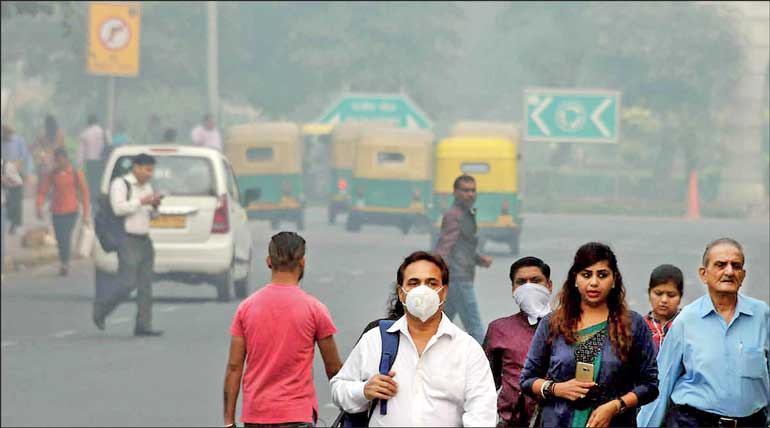Sunday Apr 27, 2025
Sunday Apr 27, 2025
Wednesday, 14 December 2022 00:00 - - {{hitsCtrl.values.hits}}

Approximately 4 million people die a year due to exposure to fine particulate air pollution

Air pollution is widely recognised as a significant threat to human health and the environment. According to the World Health Organization, particulate matter (PM), ground-level ozone, carbon monoxide, sulphur oxides, nitrogen oxides and lead are recognised as six significant types of air pollutants. Approximately 4 million people die a year due to exposure to fine particulate air pollution. According to the United Nations Environment Programme, exposure to particulate PM 2.5 µm reduced global life expectancy by approximately one year.
Particulate matter (PM) is suspended dust that has a diameter of <10 µm (PM10). PM <2.5 µm (PM2.5) are classified as fine particles and PM <0.1 (PM0.1) as ultra-fine particles. Fine particulate pollution can lead to reduced visibility in the environment. Both natural sources, such as forest fires and volcano eruptions, and artificial sources, such as industrial activity and vehicles, emit particulate matter into the atmosphere. PM can vary in size, shape, and chemical composition. The chemicals in PM can impose additional health risks.
Pollution due to particulate matter is intrinsically linked to pulmonary and cardiac-associated morbidity and mortality. The size of the particle is directly associated with the onset and progression of heart and lung diseases. Small and light-weight particles that stay suspended in the air for longer periods are inhaled through the nose or mouth. The inhalation rate depends on the aerodynamic diameter of the particle, the air movement around the nose and mouth and the respiratory rate. The inhaled particles may be deposited on the respiratory tract by sedimentation, inertial impaction, diffusion, interception, and electrostatic deposition or exhaled out of the nose and mouth.
Larger inhaled particles with an aerodynamic diameter greater than 30 µm are deposited in the nose, lips, and larynx, which can be retained by the mucosal lining. Insoluble particles in the upper respiratory system can be cleared from the areas with the upward movement of the hair (cilia) lined along the trachea, bronchi, and bronchioles. Coughing and sneezing can release these particles back into the atmosphere. In smokers, the natural clearance process of the respiratory tract can be impaired. Furthermore, macrophage cells can engulf insoluble particles, which can be transported upward and out of the respiratory system, remain in the pulmonary space, or enter the lymphatic system.
Fine and ultrafine particles can reach the alveolar region of the lungs and further diffuse into the circulatory system, reaching the heart and other organs. Fine and ultrafine particles are known to cause cardiac arrhythmias, nonfatal heart attacks, aggravated asthma, reduced lung function and premature death among the vulnerable groups with heart and lung disease. The chemical compositions of the exposed PM can be toxic to living cells, have the potential to cause cancer, alter the structure of DNA, and cause developmental malformations in foetuses. Over the years, global data has revealed that hospitalisation due to respiratory illness corresponds with the level of air pollution.
In addition to environmental pollution, workplace-based emissions can cause ill health and death, not only among workers but also for people in the wider community. Workplaces such as manufacturing, construction, and agriculture should ensure adequate precautions. Extraction systems at source or as a result of work processes should be in place to reduce worker exposure to PM with chemical compositions. For worker protection, the selection of masks or respirators should be appropriate for the type and size of the PM. A workplace exposure risk assessment and periodic medical surveillance is also essential to help identify risks early and prevent deterioration of worker health.
A blog on the health and climate crisis was recently published by SOM at https://www.som.org.uk/climate-crisis-or-health-crisis. There are useful resources at https://breathefreely.org.uk/ for occupational lung issues at work.
(Dr. Aseni Wickramatillake is a Specialist in Occupational Health, Industrial Hygiene and Ergonomics. She is a Technical Adviser at the Workplace Safety and Health Association (WSHA) and could be reached via email at [email protected].)
(Nick Pahl is the CEO, Society of Occupational Medicine (SOM), UK.)
Discover Kapruka, the leading online shopping platform in Sri Lanka, where you can conveniently send Gifts and Flowers to your loved ones for any event including Valentine ’s Day. Explore a wide range of popular Shopping Categories on Kapruka, including Toys, Groceries, Electronics, Birthday Cakes, Fruits, Chocolates, Flower Bouquets, Clothing, Watches, Lingerie, Gift Sets and Jewellery. Also if you’re interested in selling with Kapruka, Partner Central by Kapruka is the best solution to start with. Moreover, through Kapruka Global Shop, you can also enjoy the convenience of purchasing products from renowned platforms like Amazon and eBay and have them delivered to Sri Lanka.
Discover Kapruka, the leading online shopping platform in Sri Lanka, where you can conveniently send Gifts and Flowers to your loved ones for any event including Valentine ’s Day. Explore a wide range of popular Shopping Categories on Kapruka, including Toys, Groceries, Electronics, Birthday Cakes, Fruits, Chocolates, Flower Bouquets, Clothing, Watches, Lingerie, Gift Sets and Jewellery. Also if you’re interested in selling with Kapruka, Partner Central by Kapruka is the best solution to start with. Moreover, through Kapruka Global Shop, you can also enjoy the convenience of purchasing products from renowned platforms like Amazon and eBay and have them delivered to Sri Lanka.